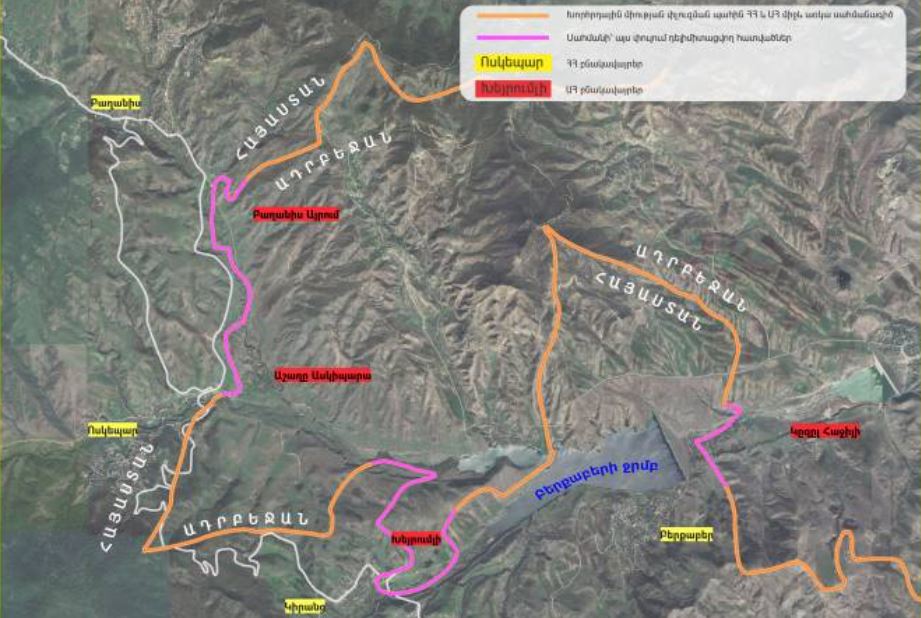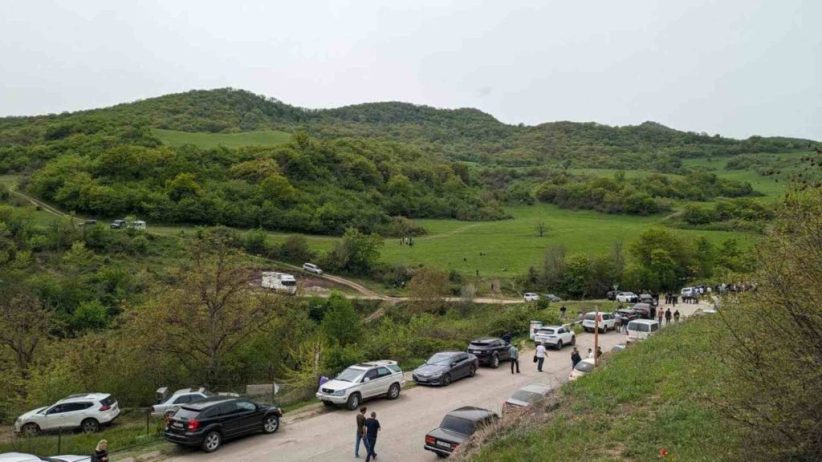By Paul Vartan Sookiasian
Earlier this month, Armenia formally launched a long-delayed process to delimit, or legally define, a section of its border with Azerbaijan for the first time, sparking ongoing protests across the country.
That process is expected to involve Yerevan handing over to Baku four abandoned villages along the border between Armenia’s northeastern Tavush region and Azerbaijan’s northwestern Gazakh district.
The announcement has been met with fierce protests in the nearby communities of Kirants and Voskepar, where scores of residents have been blocking one of the country’s main highways. They are concerned they may be forced out of their homes if Azerbaijan takes control of lands, in some cases just tens of meters away from their homes.
In the past two weeks, residents of nearby villages have repeatedly blocked roads in the area in an attempt to disrupt the delimitation process from being carried out. The village of Kirants, for instance, is already within shooting range from Azerbaijan, but this agreement would bring Azerbaijani border guards to the very edge of the village.
Also watch: Demonstrators block roads to protest planned border demarcation
As Kirants resident Andranik Nazaryan told CivilNet, the border would come close to the village’s newly built school, and even some of the village cemetery would fall under Azerbaijani control.
Former resident Gevorg Simonyan said his parents’ home lies on what would be the other side of the border and will presumably be lost. Simonyan said delimitation would bring great hardships not just to his family, but to the entire village.
What happened?
On April 19, the Armenia-Azerbaijan joint border commission, formed after the 2020 Nagorno-Karabakh war, said it reached a preliminary agreement to recognize Soviet-era administrative boundaries as international borders and formally launched a border delimitation process between Tavush and Gazakh.
In practice, that would mean Armenia handing over to Azerbaijan four villages along the border that belonged to Soviet Azerbaijan but came under Armenia’s control after independence. Last month, the head of Azerbaijan’s delegation to the border commission demanded they be ceded “immediately.”
Read more: Azerbaijan demands 4 villages as normalization talks with Armenia stall
In the past two weeks, the two sides have been working to determine the exact borderline on the ground based on geodetic measurements, with a deadline set for May 15. As of Monday, Armenia and Azerbaijan had jointly set up 35 border posts between Tavush and Gazakh, though no territories had yet been handed over.
The border between Armenia and Azerbaijan has never been delimited because it was initially an internal Soviet administrative boundary, and so it did not have to be formally defined. Soviet mapmakers largely drew boundaries along ethnic lines, which often meant forming enclaves and exclaves in areas of mixed populations, sometimes forcing key infrastructure projects to criss-cross boundaries.
After the Soviet Union collapsed in 1991, fighting broke out not just in Nagorno-Karabakh, but also between Armenia and Azerbaijan, including along the border between Tavush and Gazakh. During that war, Armenia took control of four Azerbaijani border villages in that area, forcing their residents to flee. The villages have stood in ruins ever since.
At the current stage of the delimitation process, only Armenia is giving up territory it controls despite Azerbaijan occupying at least 83 square miles of territory in Armenia, according to a CivilNet estimate, including parcels of land in Tavush. That is widely seen in Armenia as a unilateral concession, with no guarantees Azerbaijan will reciprocate.

Orange: Soviet-era boundaries not yet delimited
Yellow: Armenian villages
Red: Azerbaijani villages controlled by Armenia, set to be handed over
Source: Armenpress
Why the backlash?
Government critics say giving up these territories would compromise Armenia’s well-fortified defenses in Tavush and jeopardize a number of key pieces of infrastructure. Armenia’s main highway to Georgia runs through the area, as does the country’s sole natural gas pipeline. As of now, the only possible detour is an unpaved dirt road, and there is no easy way to reroute traffic, given Armenia’s mountainous geography.
After decades of war, it is difficult for many in Tavush to imagine how life can go on in their villages under the close watch of Azerbaijani forces.
The Armenian government insists it is not giving up any sovereign Armenian territory, and is instead only defining the exact extent of it. The day after the agreement was announced, Prime Minister Pashinyan said he welcomed what he called the first time the two countries “had resolved an issue around the negotiating table.”
Days later, Pashinyan acknowledged the delimitation process will be painful, but insisted it is being done to secure Armenia’s future.
“We are not solving the issue of a house, a village, or a road. We are solving the issue of the existence of the Republic of Armenia in the coming decades, and we will solve that issue. We have no other option,” he said.
For their part, senior officials in the European Union and United States have welcomed the border delimitation agreement.
















